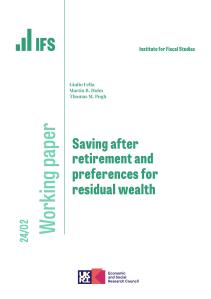There aren’t too many areas of public policy where we in the UK can feel we have done a better job than in comparable countries. Our state pension system is, arguably, one of them. What we have is vaguely coherent and more affordable than most. It forms part of a system which, alongside widespread private provision and additional means-tested support for the poorest, results in many enjoying a relatively comfortable old age, and far fewer than in the past living in poverty.
The state pension is worth just over £200 a week to nearly everyone hitting the current state pension age of 66. It accounts for getting on for half of pensioner incomes overall. Even the richest fifth of pensioners depend on state pensions for about a quarter of their income. After decades of upheaval we have finally settled on the state providing a single flat-rate benefit rather than trying to provide an earnings-related scheme. Employees are heavily nudged through automatic enrolment to provide those additional top-ups for themselves.
At about 6 per cent of national income, public spending on state pensions is well below the western European average, and less than half the eye-watering 14 and 16 per cent of GDP spent by the French and Italians respectively. And while our population is ageing, the ratio of older people to those of working age is lower here than in most developed countries, and set to rise more slowly.
Of course, not everything is entirely rosy. We can still expect to be spending an additional 1 per cent more of national income on pensions in 2050 than we do today. In part that is because life expectancy is rising, even if much less quickly than previously forecast.
Life expectancy also varies. The poorer you are, the less long you are likely to live. Men in the most deprived tenth of local areas in England can expect to live almost a full decade less than men in the richest tenth. The state pension is, therefore, worth more to the better off than to the poor, because they receive it for longer. One consequence is that if you control the cost of the pension by increasing state pension age, you take away a bigger proportion of the total receipt of the poor than of the rich.
There is still a strong case for raising the pension age. Rising life expectancy means that men born in 1950 can expect to receive a state pension for almost twice as long as those born 40 years earlier. But it does suggest that when limiting increases in spending, we need a balance between raising pension age and managing the level of the pension.
Now the curious thing about the level of the pension is that we have little idea what it will be. That is one consequence of the infamous triple lock — the annual increase in the state pension by the higher of price inflation, earnings growth and 2.5 per cent. The level of the pension into the future depends on the unknown future relationship between these parameters. My colleagues at the Institute for Fiscal Studies, as part of a review of pension policy in partnership with the abrdn Financial Fairness Trust, carried out a series of simulations. These suggest that continuing with the triple lock could, with 10 per cent probability, add less than £5 billion to spending in 2050 compared with simple earnings indexation. Or it could, with similar probability, add a whopping £40 billion or more. This is not sensible. We should agree a target level of the state pension as a fraction of earnings, take it there over a period of time and then keep it there.
All straightforward enough, but thus far I have skipped over one huge set of complexities. Most of us will retire on the full state pension. It is far simpler than what went before. But it is still, notionally, based on a contributory principle, and so not quite everyone gets that full pension. You need 35 qualifying years to do so. A qualifying year can be built up if you are in work and earning over the national insurance lower earnings limit of £6,396 per annum; which is confusingly not the same point at which national insurance contributions are actually paid — that is the primary threshold currently set at £12,570. You can also be credited into a qualifying year in a very wide range of situations, for example, if you have a child under 12 and receive child benefit, or if you are in receipt of some other benefits such as universal credit. In most cases those qualifying years should be credited to you automatically. In some situations you have to claim them; almost nobody does.
This all leads to confusion and unfairness. If, for example, you are a very low earner and don’t qualify for universal credit because your partner is a relatively high earner then you do not build up a pension entitlement. Someone earning the same who does receive universal credit would build up entitlement.
We are close to a system which bases full entitlement on long-term residence in the UK. Largely as a result of history, we have built a huge and complex superstructure aimed at ensuring most, but not all, get that entitlement. Surely it is time to simplify that and base entitlement entirely on length of residence. In addition, we should announce a long-term target for the level of the pension as a fraction of average earnings, guarantee to maintain it at that level and never to increase it by less than inflation or ever to means-test it, and be clearer about when the state pension age will rise.
These are pretty simple steps from where we are, and would get us to the sort of stable, simple, affordable system we all need.
This article was first published in The Times and is reproduced here with kind permission.










